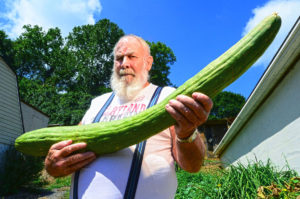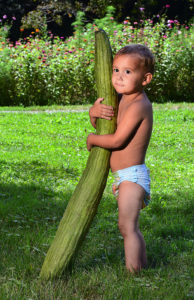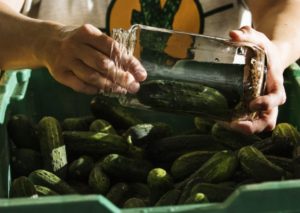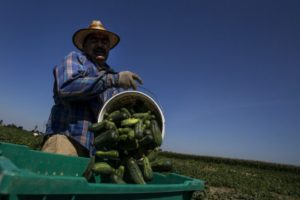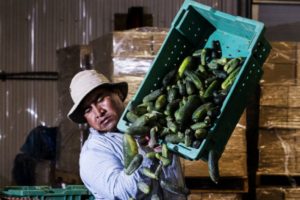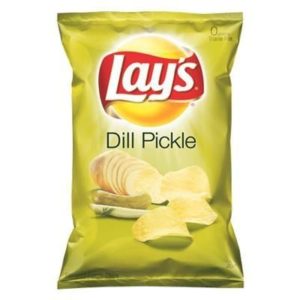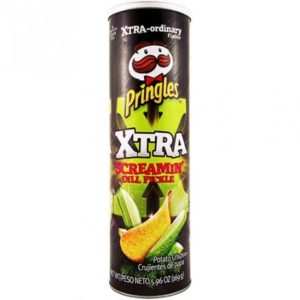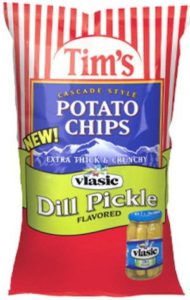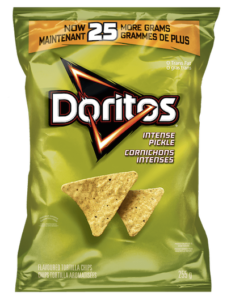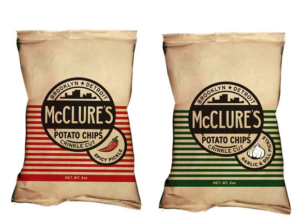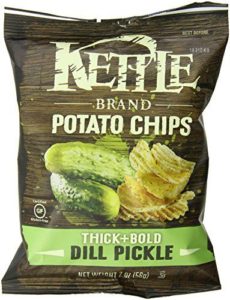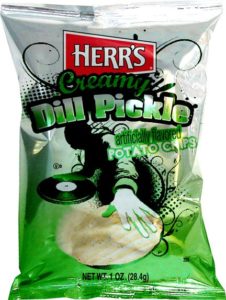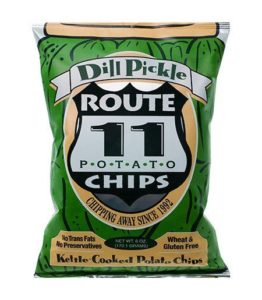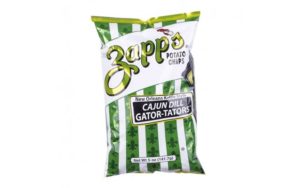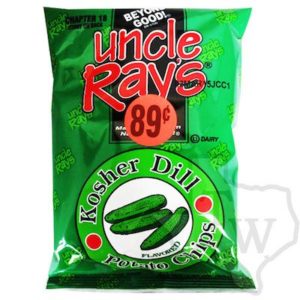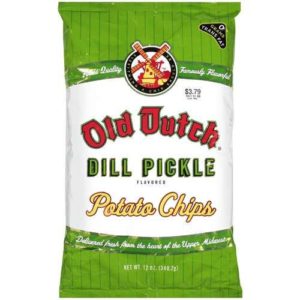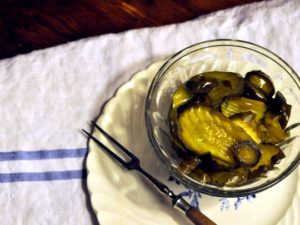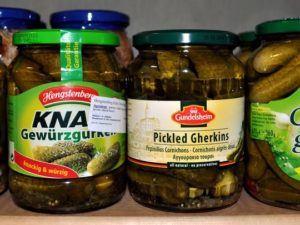By Bill Lynch , Staff Writer – Charleston Gazette-Mail
Editor’s note: Reporter Bill Lynch started 2016 on a bold mission: to immerse himself in a different facet of life for a full month — every month — for all of 2016, and write about it along the way. The idea is to take something he knows precious little about, which fortunately is a longer list than you might expect, and learn about it by doing as much as possible. In August, Bill’s tackling the fine art of food preservation.
I’ve wanted to know how to can, pickle or otherwise preserve my own food for a while, since I moved into my house outside of Charleston a few years ago. I just haven’t done much about it.
For the last four years, I’ve kept a garden in my backyard.
It’s nothing spectacular. I usually grow a couple of varieties of tomato, some zucchini, a few carrots and whatever happens to look good in the seed catalogs when they start showing up in my mailbox in December.
I am not a great gardener.
What I lack in talent, I try to make up with flagging enthusiasm. I tend to be more interested in the planning and planting and less enthusiastic when it comes to cultivating and weeding.
Still, ever year, I learn something — usually, what not to do.
One year, I grew a 6-foot row of ragweed. It looked like eggplant to me, and I had plants over 18 inches tall before I figured out what I’d done.
Most years, I grow too much of something — too many peppers, too many tomatoes, too many onions.
I also have a couple of fruit trees. Some years, I’m overrun with apples. Other years, I end up with more pears than even the deer can polish off in a single summer.
This year, I have too many cucumbers.
I don’t even particularly like cucumbers. I just grew them because I thought maybe I could make ice box pickles.
I like pickles, but don’t like cucumbers. I’m not the only one.
In hindsight, two cucumber plants would have been enough, but missing the part where someone told me how many cucumbers you get per plant, I put in five. The plants have taken over half of my garden, and, with the rainy summer, I’m getting a pound or two of cucumbers just about every other day.
I’ve tried giving them away, but there are only so many cucumbers anyone will take. At least I couldn’t get rid of that many in the newsroom. Maybe if I’d frosted them like donuts and added sprinkles …
I needed to do something before my late-planted tomatoes started to ripen and my kitchen was overrun with produce.
So I put in a call to John Porter, WVU agricultural extension agent and Sunday Gazette-Mail Garden Guru.
John is not just a go-to guy for basic gardening questions, which I’ve thrown his way a couple of times. He’s also a good source for other sort of home farming/rural living questions.
The extension office offers tons of information and hosts classes and workshops, including the occasional one about home canning, not that John needed to get a degree to learn things like canning and pickling.
He’s been doing it since he was a kid.
“I used to can with my mother,” John said. “My father used to can green beans outside over a fire in a metal drum that had been split in half.”
John didn’t recommend canning green beans that way, though it sounded kind of awesome.
“Food safety,” he explained.
Green beans, John said, should be canned with a pressure canner.
“They aren’t acidic enough,” he said.
I met John at his office, which houses a huge kitchen with three or four stoves, a couple of ovens, and more counter space than your average Taco Bell.
There were plenty of modern appliances, pots and pans of every size, and enough cabinets and drawers to hold all the stuff.
I was a little envious. My kitchen isn’t bad, but it is a little dated. Most of the major appliances were installed during the Reagan years and are slowly dying off. Two of the burners on my stove died last year, and I sort of have to kick the bottom of the fridge door to get it to shut completely.
For this lesson, I brought along my own cucumbers, but John was a step ahead of me. He brought his own.
“I got started a little early,” he said and showed me a large, clear plastic tub.
On the bottom of the tub were sliced, green cucumber sickles.
“The cucumbers I had were a little too big,” John said. “So, I cut out the centers with the seeds.”
In the pickling brine we were going to use, the seeds would likely detach and cloud the bottle. They also wouldn’t add much to the overall crispness of the pickles.
In this lesson, we were going to make bread and butter pickles, mostly because John preferred them. I was fine with whatever. I have a lot of cucumbers.
John walked me through the steps, first explaining that, to make the pickles crisper, he’d buried the cucumber slices beneath under several inches of ice and some pickling salt. They’d been chilling in the container for hours.
Pickling salt, he added, was important. It’s finer than table salt and isn’t iodized. Iodized salt can give the pickles a weird flavor.
The cucumbers had been sitting in the salt and ice for a couple of hours.
Before I’d arrived, he’d also started his canning bath in a big pot full of water, which was just coming to a boil.
Lids for the jars simmered in a separate pan of water, while the jars rested in the dishwasher. Wisps of steam rose from the closed door.
“A canner’s best friend,” John said. “It sterilizes and heats your jars for you.”
My dishwasher hasn’t worked in years.
John heated a mixture of vinegar, pickling salt, sugar and spices in a separate pot on the stove and brought it to a boil.
After draining the ice from the cucumbers, he added them to the pot and stirred with a wooden spoon.
“You want to use wood, if you can,” he said. Stainless steel was OK, too, but nothing with aluminum. “It can add flavors you don’t want.”
Once the pickles began bubbling, John took jars from the dishwasher and carefully spooned pickles and sauce into them.
“You want about half an inch of head space,” he said and then wiped the lip of the jar with a paper towel.
He wanted the lids to go onto the tops of the jar cleanly.
With a magnet-tipped plastic stick, he fished lids from the pan and gently placed them over the mouth of the jar before capping the lid with a thin, steel ring.
“Just twist it shut,” John said. “Don’t make it tight.”
We filled seven jars and then put them in a wire cage inside the bubbling canning bath. We lowered the cage into the water, and John pointed out the bubbles escaping from the jar. This was air leaving the pickles. When the canning process was completed, it would create a vacuum inside the jar.
“You’re trying to get anything out of the jar that could be a home for bacteria,” he said. “You don’t want anyone to get sick.”
Improperly canned foods can cause upset stomach, loose bowels and even death.
Botulism was the big fear.
“Botox,” John said. “It paralyzes whatever it touches. Doctors use it to paralyze nerves to remove lines on your face, but if you eat it, well … bad stuff.”
It was less of a risk with some kinds of canning, like pickles, fruit and jam. The acid of the vinegar in pickled foods discourages bacteria and sugar is a preservative.
“It used to be tomatoes were fine to can,” he said. “But so many people are growing low-acid tomatoes now that often you have to add some sort of acid to them.”
Most garden vegetables, like green beans, potatoes and meat should only be canned using a pressure canner, which heats the contents of the jars hot enough to kill bacteria. But there are also other foods that shouldn’t be canned even using a standard pressure cooker — like squash and pumpkin.
“It’s not safe,” John said.
After 10 minutes in the water, John and I removed the jars and placed them on a towel to cool and dry, explaining that hot jars might cool too fast on the cool, bare surface and break.
“They’re pretty tough jars,” he said. “But it could get messy.”
As we waited, the lids sealed over the jars with a popping noise.
“You can tell they’re sealed if you can see a slight indentation in the middle,” John said.
If the jars don’t seal, he said, you should reprocess the pickles, put them back in the canning bath and try again or you just let them cool and put the pickles in your fridge.
“You eat them like ice box pickles,” he said. “You just need to finish them up within a week or two.”
John offered me half of the pickles we (mostly he) made and gave me a copy of “So Easy to Preserve” to be my guide.
“We sell them here at cost for $15,” he said.
It seemed easy. So I bought some jars and washed a couple of pounds of cucumbers from my garden.
Here’s a great recipe for Bread and Butter Pickle Slices
Reach Bill Lynch at lynch@wvgazettemail.com, 304-348-5195 or follow @LostHwys on Twitter.
Follow Bill’s One Month at a Time progress on his blog at blogs.wvgazettemail.com/onemonth/.

